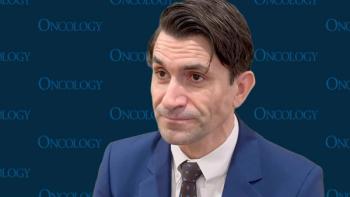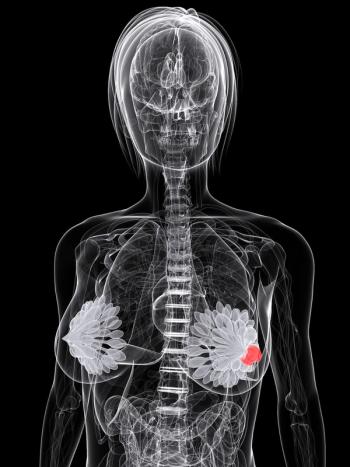
PRT811 Yields Early Anti-Tumor Activity in Uveal Melanoma/Advanced Glioma
Common treatment-emergent adverse effects among patients receiving PRT811 for uveal melanoma or advanced glioma include nausea and vomiting in a phase 1 study.
The investigational PRMT5 brain-penetrant inhibitor PRT811 demonstrated preliminary efficacy and safety in patients with IDH-positive, recurrent, high-grade glioma and those with splicing mutation (SPLC)–positive uveal melanoma, according to findings from a dose-expansion stage of a phase 1 study (NCT04089449) presented at the
Results were presented by Varun Monga, MD. During his presentation, Monga, clinical associate professor of internal medicine-hematology, oncology, and blood and marrow transplantation, Department of Internal Medicine, University of Iowa Carver College of Medicine, stated that although responses occurred in all subgroups assessed, activity was minimal in patients with IDH-negative glioma as well as in those with SPLC-negative uveal melanoma.
PRMT5 overexpression has been shown to induce tumor cell growth, leading to poor clinical outcomes. With its ability to potently and selectively target PRMT5, PRT811 is under investigation in diseases with limited treatment options, including recurrent, high-grade glioma, advanced/metastatic uveal melanoma, and central nervous system lymphomas.
“Preclinical studies demonstrate that IDH1/2 mutations and splicing on mutations such as SF3B1, SRSF2, U2AF1, re-sensitize tumor to PRMT5 inhibition,” said Monga during the presentation.1 “In the previously reported dose-escalation phase of the current study, patients treated with PRT811 at 600 milligrams daily had a mean symmetric demethylation inhibition of 83%.”
The phase 1, first-in-human, open-label, multi-center study included 86 patients. The primary end point was determining the recommended phase 2 dose of PRT811. Secondary end points included safety and tolerability, pharmacokinetics, and anti-tumor activity. In the recurrent, high-grade glioma cohort, 16 patients had IDH positive tumors and 22 had IDH negative, making the 38 patients from the cohort evaluable for response. In the advanced/metastatic uveal melanoma cohort, 10 patients were SPLC positive and 13 were SPLC negative, for a total of 23 response-evaluable patients.
The overall response rate (ORR) among patients treated with PRT811 in the glioma cohort was 5.3%, with the best overall response being a complete response. Moreover, 2.6% of patients in the cohort had unconfirmed partial responses (PRs), 28.9% achieved stable disease (SD), 52.6% had progressive disease (PD), and 22% were not evaluable.
Patients in the uveal melanoma arm had an ORR of 4.4%. In this cohort, the best response was a PR, and all were unconfirmed. SD was seen in 34.8% of the patients with uveal melanoma, 43.5% had PD, and 13.0% of patients were not evaluable.
Notably, in the IDH-positive glioma population, 2 durable CRs were observed. One patient had a CR for 31.0 months that was ongoing at data cutoff, and the other patient with a CR had a median duration of response (DOR) of 7.5 months followed by PD. In the uveal melanoma group, a patient with a PR had a median DOR of 10.0 months followed by PD.
Regarding the clinical benefit rate (CBR), Monga stated, “The odds of achieving a clinical benefit was more than 9 times higher in patients with IDH-positive versus IDH-negative glioma, and more than 5 times higher in patients with splicing mutation-positive versus splicing mutation-negative uveal melanoma, compared to patients with IHD-negative glioma and splicing mutation-negative uveal melanoma, respectively.”
Specifically, the investigator-assessed CBR was 31.3% in the IDH-positive glioma group vs 4.5% in the IDH-negative glioma group. Among patients with uveal melanoma, the SPLC-positive population had a 30.0% CBR compared with 7.7% in the SPLC-negative group.
The median duration of treatment was 2.49 months (range, 0.33-32.23) in the IDH-positive glioma cohort and 1.15 months (range, 0.03-10.05 months) in the IDH-negative glioma cohort. The median progression-free survival (PFS) shown with PRT811 in patients with IDH-positive disease was 2.46 months (95% CI, 1.41-5.62 months), and the 6-month PFS rate was 22.0% (95% CI, 5.0%-46.0%). In the IDH-negative population, the median PFS was 1.38 months (95% CI, 1.15-1.58, and the 6-month PFS rate was 5.0% (95% CI, 0%-21.0%).
Patients with SPLC-positive uveal melanoma had a median treatment duration of 2.74 months (range, 0.16-26.68), and the SPLC-positive group had a median treatment duration of 1.41 months (range, 0.23-9.23). The median PFS was 4.14 months (95% CI, 1.31 to not evaluated) and 1.4 months (95% CI, 1.28-4.93). Six-month PFS rates were 45.0% (95% CI, 11.0%-75.0%) and 13.0% (95% CI, 1.0-40;0%), respectively.
In all 61 patients in the study, any-grade treatment-emergent adverse events (TEAEs) occurred in 98.4% , and grade 3 or higher TEAEs were observed in 52.5%. Any-grade TEAES leading to dose reduction or dose interruption occurred in 78.7% of patients, and grade ≥ 3 TEAEs led to dose reduction or interruption in 19.7% of patients. Serious TEAEs were observed in 21.3%, and these serious TEAES were grade ≥ 3 in 16.4%. Grade 5 TEAEs occurred in 3.3% of patients.
The most common any-grade TEAEs were nausea (62.3%), vomiting (47.5%), fatigue (37.7%), and constipation (31.3%). The most common grade ≥ 3 TEAEs were thrombocytopenia (9.8%), anemia (8.2%), vomiting (4.9%), and muscular weakness (4.9%).
Patients included in the study were 18 year of age or older, and were resistant, refractory, or ineligible to receive standard treatment, in accordance with the study enrollment criteria. Those in the dose-expansion stage of the study had a WHO grade III-IV IDH-positive glioma, SPLC-positive uveal melanoma, or SPLC-negative uveal melanoma at baseline. In addition, the patients with uveal melanoma had measurable disease per RECIST v1.1. At baseline, in all cohorts, most patients had a median of 2.0 prior lines of therapy, and patients without a target of IDH or SPLC had more advanced disease, according to Monga et al.
Based on the study findings, the recommended phase 2 dose of PRT811 is 600 mg administered orally on a once-daily basis.
Reference
Monga V, Johanns TM, Stupp R, et al. A phase 1 study of the protein arginine methyltransferase 5 (PRMT5) brain-penetrant inhibitor PRT811 in patients (pts) with recurrent high-grade glioma or uveal melanoma (UM). J Clin Oncol. 2023;41(suppl 16):3008-3003. doi 10.1200/JCO.2023.41.16_suppl.3008
Newsletter
Stay up to date on recent advances in the multidisciplinary approach to cancer.

















































































